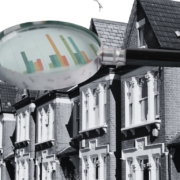Recessionary risks are rising in the US in the form of a record slowdown in US house price growth and another dent in consumer confidence.
Indications of a decelerating economy may be unwelcome guests at the table for homeowners, and companies in the wider economy, but their presence has been welcomed by Wall Street, as a sign that punishing interest rate rises will soon start to slow.
The S&P 500 lifted for another session, rising by 1.6% and building on the rally of recent days, amid hopes that the Federal Reserve might opt for smaller rate rises at the next meetings, and that the end to the cycle of tightening might be in sight that bit sooner.
The house price party is not just being punctured in previously identified bubbles but in slower growing areas too.
There’s evidence that the relentless ramp up in interest rates is taking its toll on the appetite to borrow.
While prices have still increased year on year, they have slowed a record pace, dropping from a 15.6% gain in July to an increase of 13% in August.
The Conference Board’s Consumer Confidence Index fell by more than expected in September, sentiment which is also set to feed through to a further dampening of demand in the housing market.
In the UK political kitchen, the cast of the latest series of the Great British Reshuffle has been assembled, ready to start cooking up their latest policies.
Jeremy Hunt, the continuity candidate at the Treasury, is desperate for some dough to rise but recognises the risks of upsetting the bond market judges by not crossing out enough on his shopping list.
Spending cuts are expected to be high on his page of ingredients for a more stable financial environment but that won’t help the head chef, Prime Minister Rishi Sunak, in the popularity stakes.
There was a warning in the new PM’s maiden speech that he was not going to return to his pandemic era generosity, citing ‘limits,’ and his unwillingness to leave a debt to settle for future generations.
However, the phrasing may give him some much needed headroom in terms of structuring the national debt and a more elastic timeframe for book-balancing.
Desperate for a bit of harmony he’s brought together faces new and old around the cabinet table, but some of those more loyal to team Truss have gone.
So far there’s been cautious applause in response to the new line up from the audience of investors.
The pound has climbed further against the dollar, surging above $1.14 helped by slowing US house price growth, while UK borrowing costs have also fallen further with long-dated government debt back at the levels prior to the infamous Trussenomics mini-budget.
30-year gilt yields have dropped back to 3.66%, down from a peak of almost 5.1%, while 10-year yields have also fallen back to 3.63%.
The heat in the kitchen could rise again, as daunting problems are scrawled large on the board, not least the looming recession and smouldering issues such as acute labour shortages and the struggles with Europe.
Recipes for growth will be hard to follow without the workers to propel productivity or a reduction of trade red tape.
But with the immigration and Brexit hard-liner, Suella Braverman, back in her seat at the Home Office, there are unlikely to be any quick solutions plated up.























Comments